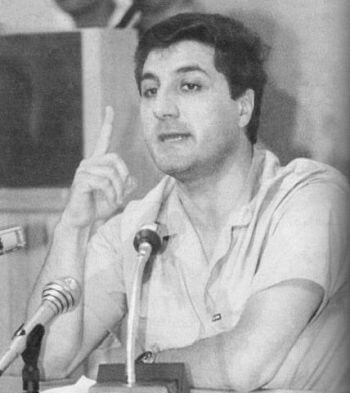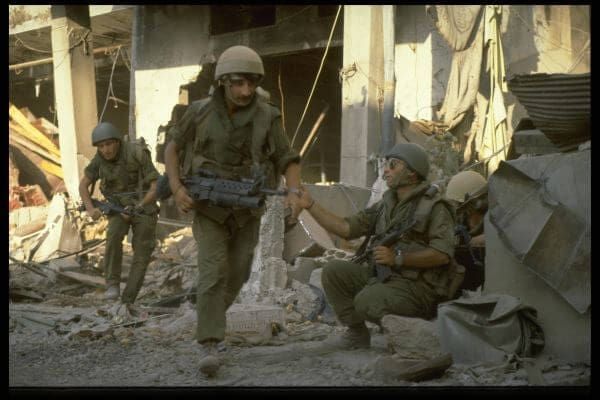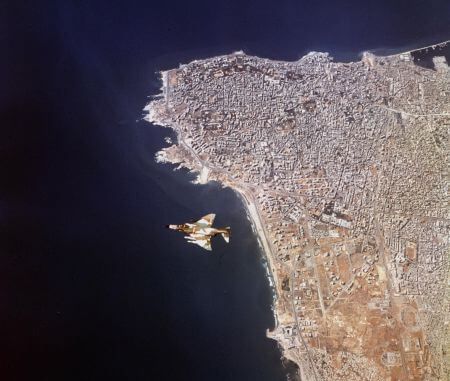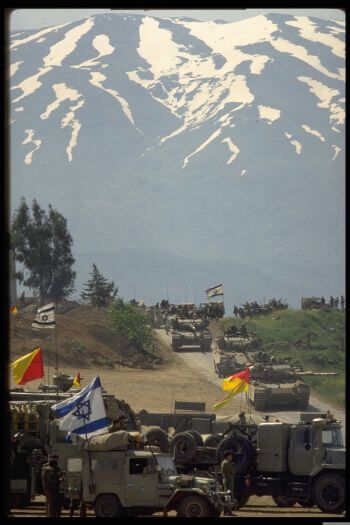The 1982 Lebanon War began when Israeli forces first entered Lebanon on June 6, in an operation named “Shalom Hagalil” – “Peace for the Galilee.” That name describes precisely what Israel sought to accomplish through this “invasion” – providing peace and quiet for Israeli citizens living in the Galilee, the region along the Israeli-Lebanese border.
Descriptions of Israel as “invading” Lebanon present Israel as seeking to conquer enemy territory. But once the full background is provided, a very different picture emerges.
Israel had lived in relative peace with Lebanon to its north, until 1968 when the Palestine Liberation Organization (PLO) began to take root in southern Lebanon, using the location as a launching pad for terror attacks inside Israel.
In 1976, Israel began to assist Lebanese Christian militias who fought against the PLO. This relationship peaked in 1978 when, in response to the Coastal Road Massacre in which PLO terrorists killed 38 Israeli civilians, including 13 children, and wounded 71, Israeli forces entered southern Lebanon in order to establish a security buffer zone to keep the terrorists away from the Israeli border. The zone’s residents were mostly Christians and Israel began to supply arms and provide training for them.
Join the fight for Israel’s fair coverage in the news

Israel’s primary partner in the effort to combat the PLO was the Maronite Phalange party led by Bashir Gemayel. Hundreds of Lebanese militia members began to receive training at the IDF Staff and Command College in Israel and Israeli leaders began to formulate a plan for the installation of a pro-Israel Christian government in Lebanon that would work to remove the PLO from the country. The UN Security Council passed Resolution 425 in March 1978 requiring all Israeli forces to leave southern Lebanon and established the United Nations Interim Force in Lebanon (UNIFIL) to assist the Lebanese government with taking control over the area, as opposed to the PLO.
Despite the presence of UNIFIL, the PLO terror attacks against Israel prompted Israel to respond, at times deeper into Lebanese territory. For example, on July 17, 1981, the Israeli air force launched a massive attack on PLO buildings in downtown Beirut, the Lebanese capital, in an attempt to prevent further terror attacks ordered and planned from those headquarters. Despite a US-brokered ceasefire following this robust Israeli reprisal attack, there were 270 attacks against Israel by the PLO from July 1981 to June 1982.
On June 3, 1982, Shlomo Argov, Israel’s ambassador to the United Kingdom, was shot and seriously wounded in London by terrorists belonging to the Iraqi-backed Abu Nidal terrorist organization. Despite the PLO distancing itself from any involvement in the attack, Israeli Prime Minister Menachem Begin blamed the PLO and its worldwide terror campaign against Israel and Jews, and used the shooting as a justification to do what Israel felt necessary for some time – enter Lebanon to uproot the terror organization once and for all.
On June 4, the Israeli government voted in favor of a massive operation in Lebanon with Begin saying “this will prevent another Treblinka,” referencing the Nazi extermination camp which the PLO would want to set up if it ever could in order to eliminate Israelis.
The government set out four goals for the IDF going into Lebanon:
- Destroying the PLO infrastructure in Lebanon, including the PLO headquarters in Beirut.
- Driving Syrian forces out of Lebanon.
- Installing a Christian-led government in Lebanon with Bachir Gemayel as president.
- Signing a binding, long-lasting peace treaty with the new Lebanese government.
Quite remarkably, the operation accomplished nearly all of its objectives.
Israeli forces under the direction of defense minister and future prime minister Ariel Sharon, launched a three-pronged attack of southern Lebanon on June 6. Approximately 60,000 troops and more than 800 tanks, along with heavy support from fighter jets, attack helicopters, artillery, and missile boats, crossed the border into Lebanon in three areas. At the same time, Israeli armor, paratroopers and naval commandos sailed towards the Lebanese coast.

Just to give a sense of the challenge facing the IDF in this operation, Israel had no choice but to attack three Palestinian refugee camps – Rashidieh, Burj al-Shamali, and al-Bass – that were used as PLO bases. Each of these camps was filled with networks of bunkers, trenches, and firing positions. Before attacking each camp, the IDF blasted warnings via loudspeakers, asking the civilians to leave before they started their air, artillery, and infantry assaults. Israeli soldiers had to engage in difficult urban combat in the narrow streets of these camps in order to ensure that no PLO leaders or fighters remained. The PLO terrorists fought vigorously but also used civilians as human shields, making the fight much more difficult for the IDF. It took Israel a full three days of fighting to secure Burj al-Shamali and al-Bass, and four days to secure Rashidieh.
Fighting took place in Ein al-Hilweh, another refugee camp used as a base by the PLO, where the fundamentalists shot any civilian who wanted to surrender when they heard the Israeli warnings over the loudspeakers. The PLO terrorists and other radical Muslims fought over every alley and house and it took the IDF eight days to secure the camp. The last terrorists fought from inside a mosque which the IDF had no choice but to destroy.
When, on June 14, the IDF reached the outskirts of Beirut, the Lebanese capital which housed the PLO leadership, Israel decided not to capture it by force since the heavy street fighting which would be required to do so would cause heavy casualties. The Syrians, who committed 30,000 soldiers to the war, joined together with PLO fighters to defend Beirut. So instead of trying to enter it, Israeli forces encircled and besieged the city while it bombed PLO targets, including trying to assassinate its leaders from the air. The siege continued until August when an agreement was reached in which more than 14,000 PLO fighters and 6,500 Fatah combatants left Lebanon under the supervision of peacekeeping troops from the United States, the United Kingdom, France and Italy. These terrorists relocated in Jordan, Syria, Iraq, Sudan, Yemen, Greece and Tunisia, which became the new headquarters for the PLO leadership.

Despite the success in expelling the PLO from Lebanon and the arrival of peacekeeping forces, smaller Islamist militant organizations, mostly back by Iran, began to launch guerrilla attacks against Israeli soldiers, including suicide bombings. The worst were two attacks against Israeli security headquarters in Tyre which killed 103 Israelis. These attacks forced the IDF to move further south within Lebanon and hold a smaller buffer zone. The various small Islamic militant groups began to consolidate into larger groups and Hezbollah eventually emerged as the leading radical Islamic organization in southern Lebanon.
Despite the setback of the continued attacks by these radical groups, Israel had succeeded in expelling the PLO from Lebanon, removing Syrian influence from Lebanon and installing Bachir Gemayel as president over a Christian government. The next step was to be a peace treaty between Israel and Lebanon. But President Gemayel was assassinated in September 1982 making it very difficult for Israel to remain deep inside Lebanon and preventing the possibility of the signing of a peace treaty.

Israel began to withdraw its troops in January 1985 and completed this process in June of that year, effectively ending the war. Israel did leave smaller numbers of soldiers in the buffer zone it felt it needed to prevent terror and rocket attacks against northern Israeli communities. Israel’s complete and total withdrawal from Lebanon would take place in May 2000.
It is interesting to note that despite the quiet which Operation Peace for the Galilee brought to the citizens of northern Israel, early in the war, a United Nations commission issued a report saying that by entering into Lebanon “the government of Israel has committed acts of aggression contrary to international law” and that the government of Israel had no valid reasons under international law for its invasion of Lebanon. In June of 2000, following the complete Israeli withdrawal from southern Lebanon, the UN announced that Israel was in compliance with UN policy and resolutions regarding Lebanon.
The civil war between the Christian Lebanese and the Islamists would continue for five more years, ending with Syrian control over Lebanon. 850,000 Christians permanently fled Lebanon during the civil war. Syria eventually pulled its troops out of Lebanon in 2005.
The war took a terrible toll on both sides. Estimates range from 2,000-19,000 killed on the Lebanese side and tens of thousands injured while Israel lost 657 soldiers with 3,887 injured. Israel lost another 559 soldiers between June 1985 and its complete withdrawal from Lebanon in 2000. 10 Israeli civilians were killed and 248 wounded from PLO and other terrorist shelling of northern Israeli communities from June 1982 when Israel attacked to 2000 when Israel withdrew.
Related reading: The Hezbollah Threat to Israel
In a horrific incident in September 1982, the Israeli-allied Lebanese Christian militia, known as the Phalangists, entered the Sabra and Shatilla refugee camp where an estimated 2,000-3,000 terrorists had remained, and massacred 700-800 civilians. Israel’s Kahan Commission concluded that the Gemayel Phalangists were directly responsible for the massacre and that no Israelis were deemed directly responsible. However, it did state that Ariel Sharon bore responsibility for allowing these Lebanese forces to enter the camps and not preventing the massacre, ultimately leading to his resignation as defense minister.
Operation Peace for the Galilee cleared the PLO out of Lebanon, providing Israel’s northern cities with a long-term respite from the horrific terror attacks which PLO terrorists had been carrying out and enabled them to live without fear of those attacks. But as often happens when the IDF agrees to withdraw from an area, the absence of an IDF presence in southern Lebanon allowed for the growth of a new terror organization, the Iranian-backed Hezbollah, which would eventually begin to terrorize Israel with its rocket arsenal.
Liked this article? Follow HonestReporting on Twitter, Facebook, Instagram and TikTok to see even more posts and videos debunking news bias and smears, as well as other content explaining what’s really going on in Israel and the region.
New! Skip the social scroll and get the latest from HonestReporting via Telegram.
Images Gemayel via Wikimedia Commons;

